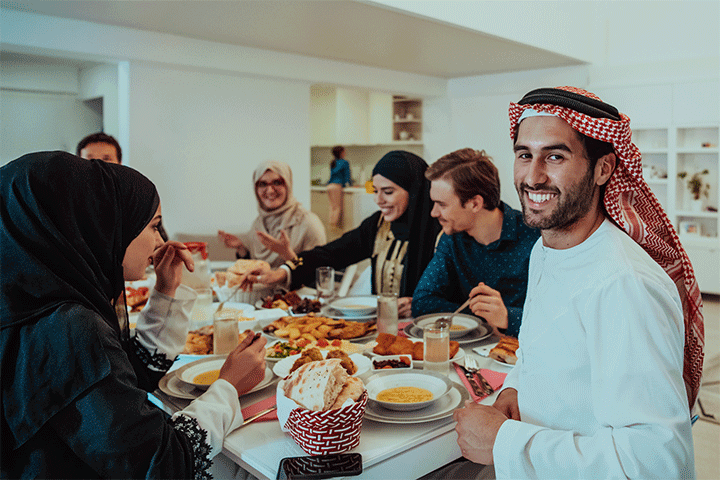The world-traveling American chef Anthony Bourdain once said, “You learn a lot about someone when you share a meal together.”
This is sage advice, especially for those who are learning Arabic. Indeed, just looking at an Arabic food menu can tell you more about Arab culture than any textbook ever could. And the first time you sit and share some delicious home-cooked Arabic food, you’ll know exactly what we mean.
However, there’s more to learn about Arab food culture than, well, just the food. Arabs also have certain rules of dining etiquette that are just as customary as using traditional Arabic food recipes.
So, whether you’re dining out at an Arab restaurant or invited over for a home-cooked Arab meal, prepare yourself. Study these tips on Arab dining etiquette so you can relax and enjoy that tasty Arabic cuisine:
Pork Chops and Pinot Noir? How about Pin-No-No!
As most Arabs you’ll meet are Muslims, that means pork and alcohol are forbidden. Think of it this way, however. At least you won’t have to worry about what wine goes best with your stuffed pork tenderloin. Anyway, it’s more than likely that you’ll be served the more halal (allowed) chicken or lamb.
Yes. No. Maybe?
Okay, so there’s this game that you have to play whenever you’re a guest in an Arab home. Here’s how it’s played:
First, you must accept any food, drinks, or snacks offered to you; otherwise, it’s considered rude if you refuse. However, there’s a caveat. The first time you’re offered anything from a glass of water to a bowl of fruit, you must politely refuse. The host will then insist that you have just a little, at which time you then accept whatever is offered.
Your Right Hand, Man
In the old days of Arab culture, people used their left hands to clean themselves going to the bathroom. Thus, the left hand is considered unclean until today as a result. On the other hand (pun intended), the right hand is considered sanitary and is used for greeting and eating. Of course, you sometimes need to use both hands, like to break bread, for example. That’s totally okay to do, but never, ever eat with your left hand or offer anybody else food with it. Likewise, always wash your hands before touching any food. Not only is it good hygiene, but it’s also good Arab etiquette.
A (Not So) Clean Plate
“Clean your plate or no dessert!” How many of you grew up hearing that from your mom every night at dinner? Well, you don’t have to be a member of the clean plate club at an Arab meal. Sure, your Arab hosts add pile after pile of food to your plate. So much so, in fact, that you’ll feel that they’ll have to roll you home when it’s time to leave. Still, tradition dictates you leave a little on your plate at the end, but don’t leave too much. A little is a sign of showing you are full while too much may leave your hosts thinking you didn’t like their food.
Eat and Run?
Leave shortly after dinner. That doesn’t mean you have to eat and run. It’s more like eat and walk. In Arab culture, dinner is usually the high point of the night. It’s the time when you enjoy each other’s company and have great conversations. If you stay too long afterward, your guests may think you didn’t get enough of their company. This is seen as impolite. So again, you don’t have to finish that last bite and head for the door. Likewise, you shouldn’t hang around too long after, either.
Following these simple rules of dinner etiquette ensures your newfound friends that you have love and respect for them. They’ll also love and respect you in return for taking the time to understand them and their culture as well.
Until next time, sahtain which means Bon Appetit!
—
Did this blog post leave you hungry to learn more about Arab culture and the Arabic language? Well, then why not help satiate your appetite by downloading the Kaleela Arabic Learning app today?
Kaleela takes you step-by-step through the Arabic learning process from the Arabic alphabet to local Arabic dialects. Along the way, you learn the five main skills of learning any language – reading, writing, listening, speaking, and culture. What’s more, Kaleela also brings you convenience. No more sitting in stuffy classrooms for hours or trying to fit learning Arabic into your schedule. With Kaleela, you’ll learn Arabic where you want when you want – all at your own pace.
Try it for yourself and see how fun and easy to use learning Arabic is with Kaleela. Get it today – only from kaleela.com.
Kaleela – Learn Arabic the Right Way.




